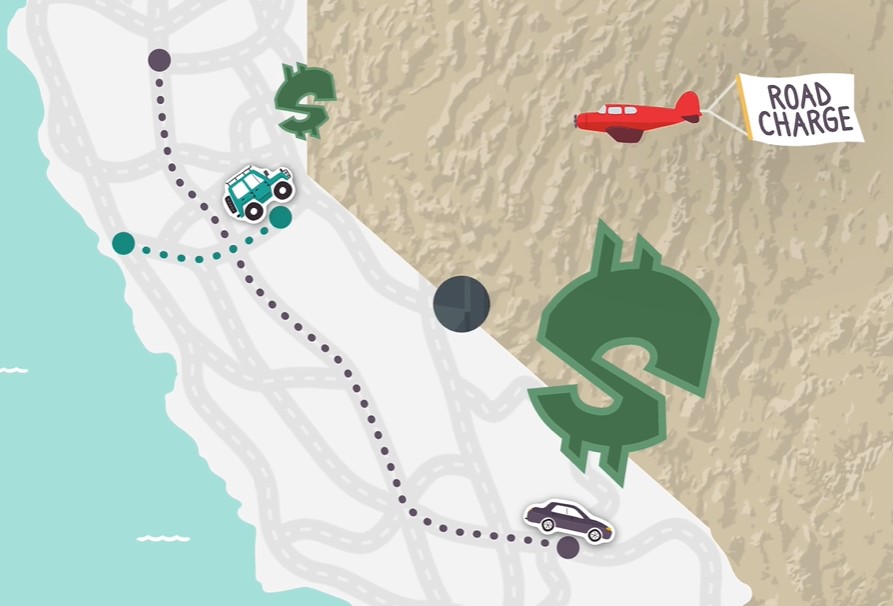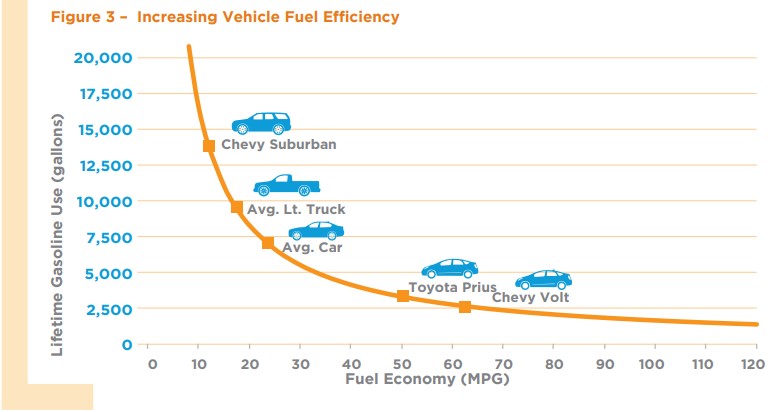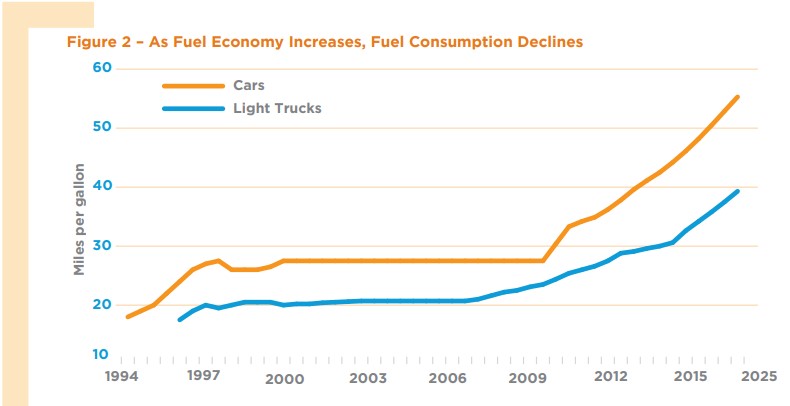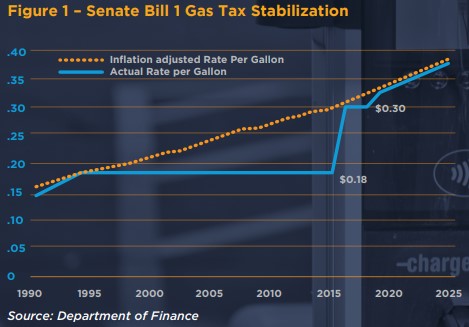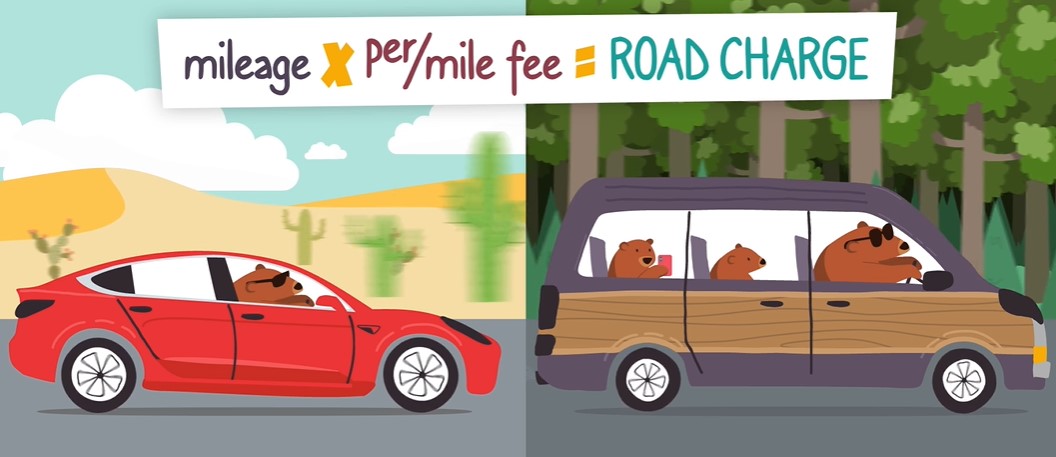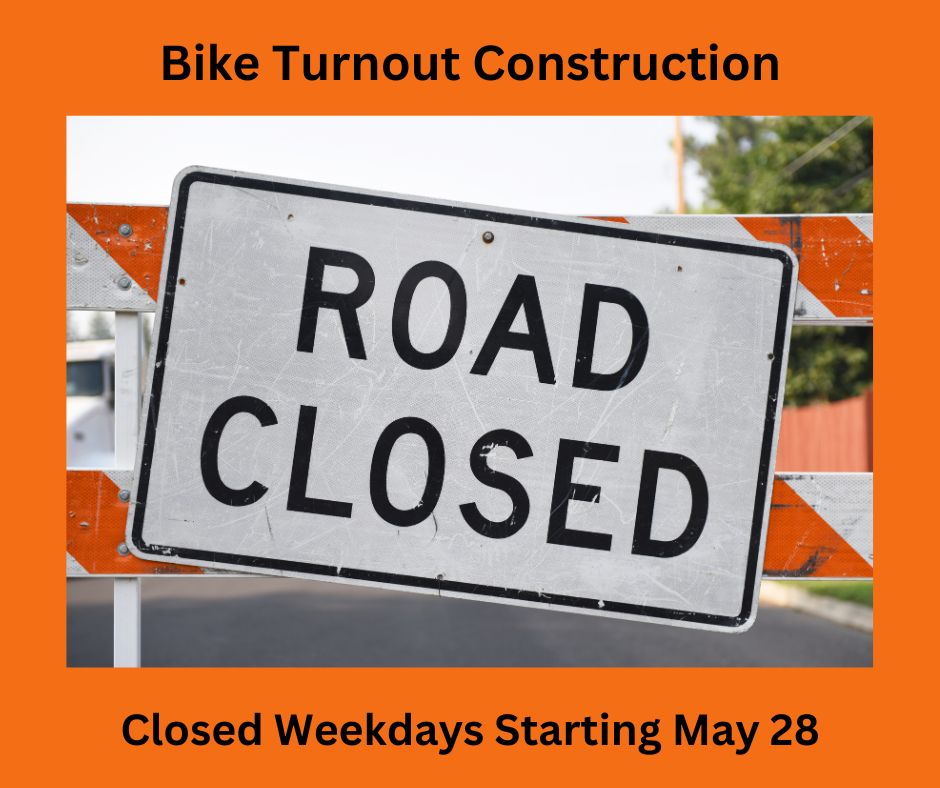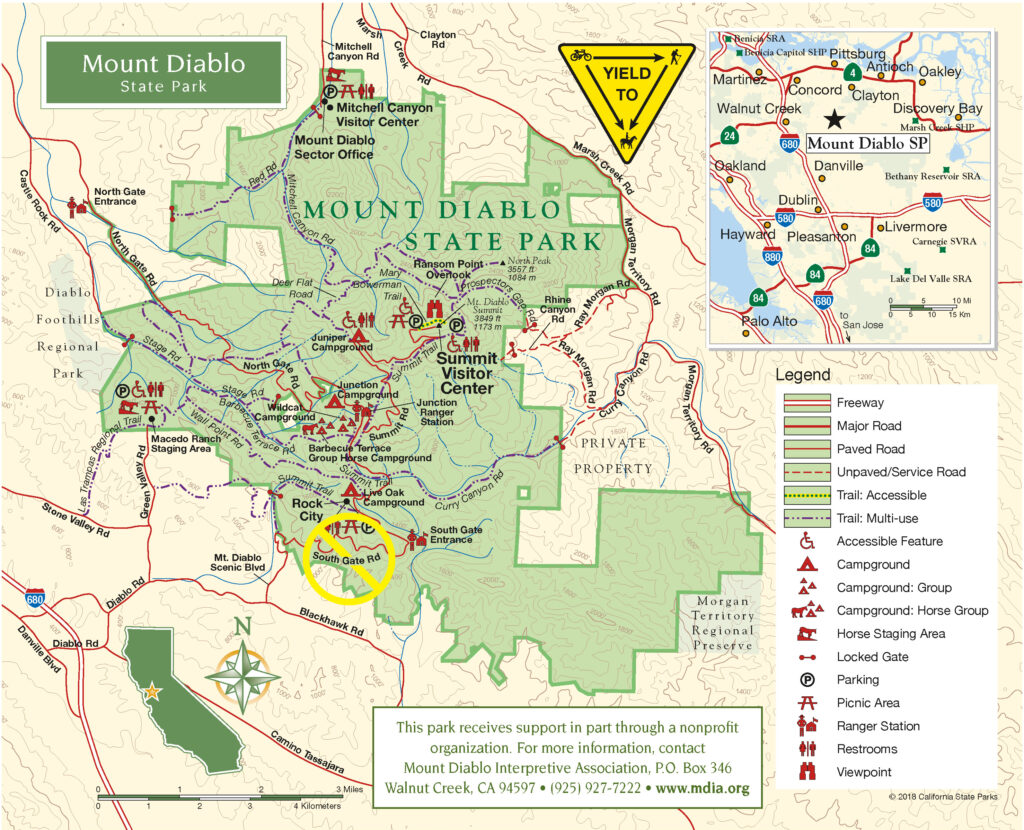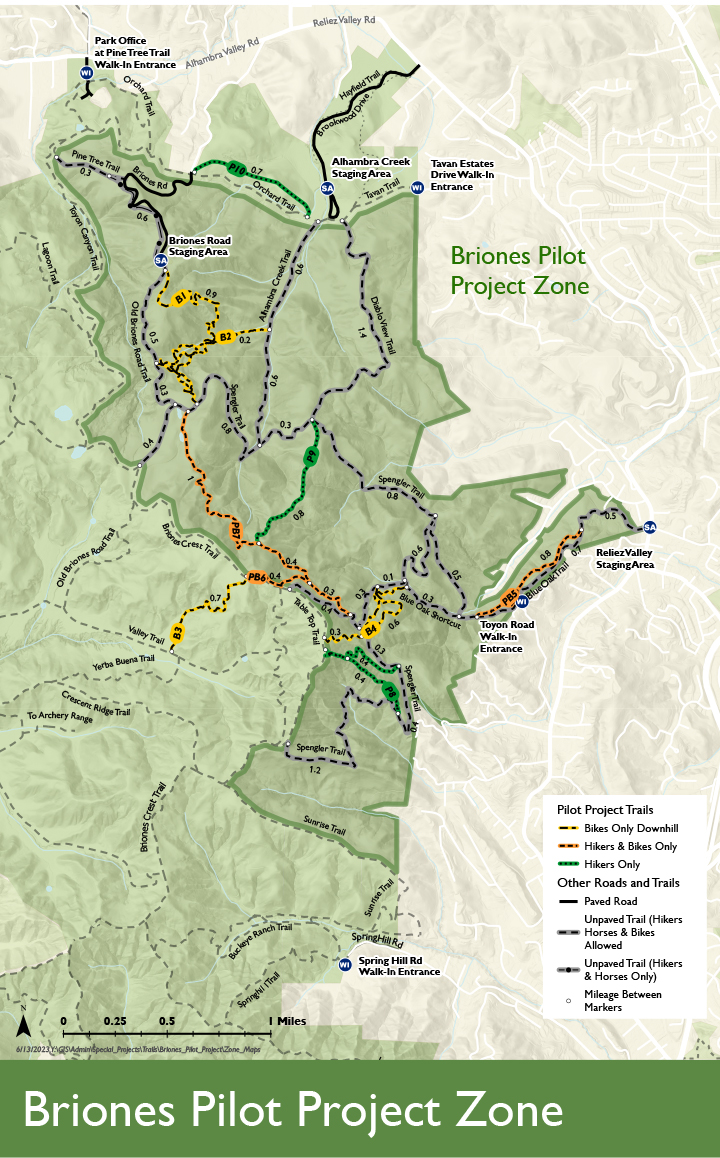Nearly $2 billion in statewide investments to improve, protect state’s infrastructure
By Edward Barrera, Division Chief of Public Affairs, California Department of Transportation
SACRAMENTO — Earlier this month, the California Transportation Commission (CTC) allocated $1.9 billion to support transportation infrastructure projects that play a starring role in powering the world’s fifth largest economy. The approved funding provides significant investments for bridges, roadways, transit and improved facilities for people who walk and bike.
The latest allocations also include nearly $430 million from the federal Infrastructure Investment and Jobs Act of 2021 (IIJA) and $740 million via Senate Bill (SB) 1, the Road Repair and Accountability Act of 2017.
A total of $10.183 million was allocated for improvements in Contra Costa County with most of it for 20 miles of BART track and $3.6 million for I-680 in San Ramon and Danville.
Among the efforts spurred by the $1.9 billion commitment include several projects prioritizing the state’s vital bridge network, highlighted more than $4 million to repair bridge damage along Interstate 80 in Alameda County.
Also included are projects that will build or renovate shoreline embankments, bus, bicycle and pedestrian infrastructure, and railroad overcrossings.
“California’s transportation infrastructure is critical to the economic and cultural lifeblood of our state, and this funding provides key support in our mission to provide a safe, equitable and sustainable transportation system for all users,” said Tony Tavares, Caltrans Director.
Contra Costa County Projects
- $6 million allocation for BART Expansion and Contraction of Steel Rail in Contra Costa County which will destress twenty miles of rail track within the BART operating corridor that has been identified as being affected by such conditions in Contra Costa County. (Funding description and source: Locally-Administered Local Transportation Climate Adaptation Program Project off the State Highway System – Resolution LTCAP-A-2324-04)
- $3.6 million allocation for I-680 in San Ramon and Danville, from Alcosta Boulevard to north of Diablo Road. Rehabilitate pavement, upgrade guardrail, and upgrade facilities to Americans with Disabilities Act (ADA) standards.
- $500,000 allocation for the Pavement Resurfacing Project, which will focus on applying pavement rehabilitation treatments in various streets located in the southeast area of the City of Martinez to improve the City’s overall pavement condition index and reduce on-going maintenance. Project will also include ADA curb ramp improvements, restoration of vehicle detection sensors at signalized intersections, striping restoration, and green infrastructure improvements. (Funding description and source: Locally-Administered SB 1 Local Partnership Program (LPP) (Formulaic) Projects Off the State Highway System – Resolution LPP-A-2324-38)
- $83,000 allocation for the Morello Avenue sidewalk gap closure in Martinez will address gaps of concrete sidewalk on the east side of Morello Avenue, south of Village Oaks Drive; and the east side of Morello Avenue, north of Arnold Drive. Improvements will also new curb and gutter, and a new ADA curb ramp at the southeast corner of Morello Avenue/Village Oaks Drive. (Funding description and source: Locally-Administered SB 1 LPP (Formulaic) Projects Off the State Highway System – Resolution LPP-A-2324-38)
The Contra Costa projects funded are among multiple approved projects in District 4 – Bay Area / Oakland which includes Alameda, Contra Costa, Marin, Napa, San Francisco, San Mateo, Santa Clara, Solano and Sonoma counties.
IIJA, known as the “Bipartisan Infrastructure Law,” is a once-in-a-generation investment in our nation’s infrastructure to improve the sustainability and resiliency of our energy, water, broadband and transportation systems. Since 2021, California has received more than $42 billion in IIJA funds, including more than $29 billion for transportation-related projects.
In addition, SB 1 provides $5 billion in transportation funding each year that is shared between state and local agencies. Road projects progress through construction phases more quickly based on the availability of SB 1 funds, including those partially funded by SB 1.
See the complete list of the latest CTC-approved projects in each of the other nine Caltrans Districts in the state:
District 1 – Eureka (Del Norte, Humboldt, Lake and Mendocino counties)
District 2 – Redding (Lassen, Modoc, Plumas, Shasta, Siskiyou, Tehama and Trinity counties)
District 3 – Marysville / Sacramento (Butte, Colusa, El Dorado, Glenn, Nevada, Placer, Sacramento, Sierra, Sutter, Yolo and Yuba counties)
District 5 – San Luis Obispo / Santa Barbara (Santa Barbara, San Luis Obispo, Monterey, San Benito and Santa Cruz counties)
District 6 – Fresno / Bakersfield (Kings, Tulare, Fresno, Madera and Kern counties)
District 7 – Los Angeles (Los Angeles and Ventura counties)
District 8 – Riverside and San Bernardino counties
District 9 – Bishop (Inyo, Kern and Mono counties)
District 10 – Stockton (Alpine, Amador, Calaveras, Mariposa, Merced, San Joaquin, Stanislaus and Tuolumne counties)
District 11 – San Diego (San Diego and Imperial counties)
District 12 – Orange County
For more information about California transportation projects funded by IIJA and SB-1, visit RebuildingCA.ca.gov and www.build.ca.gov.
Allen D. Payton contributed to this report.
Read More
Willie James Mims
November 30, 1944 – May 22, 2024
Willie James Mims was born to Edward and Lillie Mims on November 30, 1944, in McCaul, LA. He was one of nine siblings. He lived in California since he was two years old. Willie grew up in West Pittsburg, now called Bay Point, California, where he attended and graduated from Pacifica High School in 1963. In high school, Willie excelled in sports, including track and field, basketball, and football. Willie was concerned about issues revolving around environmental justice, especially in Pittsburg. In 1963, he entered the political arena for the first time, passing out flyers supporting the Rumford Fair Housing Act. George Ealy, a local political activist, organized that event.
Willie married Darlene Lea-Mims on July 15, 1967, and they celebrated 52 years of joyous marriage before she preceded him in death. From this union, they have two children, Dana and Marcus; six grandchildren, Tasha Thompson, Nailah Thompson, Khiry Gosha-Mims, Zaheem Smith, Niara Mims, and Inaya Mims; and two great-grandchildren, Khira Gosha-Mims and Chance Gosha-Mims.
Willie graduated from Diablo Valley College in 1972 with an Associate of Arts Degree. He then transferred to San Francisco State University and earned a Bachelor of Arts in English/Creative Writing in 1974. He proceeded to graduate school, where, in 1978, he earned an M.A. Degree in English/Creative Writing. Willie’s thesis was a collection of short stories called “The Boy Who Threw Rocks,” loosely based on his childhood. Willie then earned a California Secondary Education Teaching Credential in English in 1979.
From 1965 to 1970, he was employed as a stevedore with the Concord Naval Weapons Station. From 1971 to 1987, he worked as a food service worker at the Veterans Administration Hospital in Martinez, California. Willie worked for the Vallejo City Unified School District for over 25 years, serving as Teacher/Teacher-in-Charge at John Finney High School, formerly Peoples High School. He retired from wage work in 2009.
Since retirement, he continued as an activist, advocating for the best interests of the community, parents, and students in the school system. Willie believed that parents and activists should monitor and observe the school districts in East County. This included monitoring and observing local governments and how they conduct the people’s business.
He attended local and county-wide meetings (mainly those in Central and East Counties), bringing issues of concern to School Boards, City Councils, and the Board of Supervisors. His goal on all issues was to support students, parents, or people in their grievance redress.
Willie was a former mentor of the S.I.M.B.A (Safe In My Brother’s Arms) program, which focuses on boys from 8 to 16 to support self-esteem and served as a form of “manhood” training. He was a former East County Boys and Girls Club board member. He served as an “on-call” Educational Advocate for the YIN (Youth Intervention Network) Program. He served as a volunteer historian for the Parents Connected Organization. He was a representative of the Black Political Association in Pittsburg, CA, and a member of the Executive Committee of the East County National Association for the Advancement of Colored People (NAACP), where he served as its Education Chair. He worked as a volunteer for the Greater Faith Food Pantry, an agency serving and feeding low-income and underserved citizens of Pittsburg. He was a member of its board and volunteered four times per month. He was a member of the Antioch School District’s African American Male Initiative, a former representative on the Contra Costa Community College’s Hiring Policy Review Committee, a member of the Mt. Diablo Unified School District’s Equity & Disproportionality Committee, and a member of the Vallejo Unified School District’s LCAP & LCFF Committees.
Willie was preceded in death by his parents, Edward and Lillie Mims, his sisters Wilma Douglas and Isabel Medford, and his brothers Melvin Mims, Mack Mims, and Walter Mims. He leaves behind his two children, Dana and Marcus (Cassandra) Mims; six grandchildren, Tasha Thompson, Nailah Thompson, Khiry Gosha-Mims, Zaheem Smith, Niara Mims, and Inaya Mims; and two great-grandchildren, Khira Gosha-Mims and Chance Gosha-Mims. He is also survived by sisters: Hilda Murdoch (Pittsburg), Nancy Mims-Burt (Pittsburg), and Ruth Mims-Jemerson (Oakland), Melodye Montgomery (Alameda), daughter-in-law Cassandra Waller-Mims, a brother-in -law/friend Larry Harold, who was always by his side, and a host of nieces, nephews, cousins, friends, and lastly, the East Bay Community.
Willie’s main goal was to educate, motivate, and support his community. He leaves a legacy of love, compassion, and service that will continue to inspire all fortunate enough to know him. Willie James Mims will be missed by his family, friends, and the community.
You can send flowers to the family or plant a memorial tree in memory of Willie Mims.
Services will be held at 11:00 AM on Saturday, June 1, 2024, at Delta Bay Community Church, 1020 E. Tregallas Road in Antioch. Repast immediately following burial at Pittsburg Youth Development Center at 1001 Stoneman Avenue in Pittsburg.
To watch online visit zoom link ID: 740 600 9196, Password: 2024
Donations in his memory to the Willie J. Mims Education Scholarship for East County Youth are accepted at www.obituare.com/willie-james-mims-obituary-133141/.
Read MoreSponsors needed
By Sophia Martin, Regional Director, Love Life NorCal Antioch
Please support us in our annual fundraiser, LifeRide. We will be riding bikes across the nation to raise awareness and funds to unite and mobilize the Church to end abortion and the orphan crisis.
What is LifeRide?
In 2023, Pastor Jay Stewart at the age of 60, rode his bicycle over 3,100 miles across America to bring awareness to the ministry of Love Life and to raise over a million dollars. Pastor Jay has been a partnering pastor with Love Life from the beginning and his church is also a House of Refuge church. (See video1 and video2)
Locally, our goal is to raise $10,000. If you would like to give $25, $50 or $100 to help us meet our goal and learn more, please visit: https://join.liferideusa.org/team/580862.
“Rescue those who are being taken away to death; hold back those who are stumbling to the slaughter.” – Proverbs 24:11
For more information about Love Life visit https://lovelife.org and to sign up for a 1-Hour Journey visit: https://lovelife.org/1-hour-journey. Get your Love Life apparel and coffee here: https://shop.welovelife.org/?ref=antioch.
Read MoreDue to purchase and use of hybrid and electric vehicles
Receive up to $400 in gift cards for 6-month Pilot program beginning Aug. 2024
By Allen D. Payton
Caltrans has launched a test on the proposed per mile Road Charge to possibly replace the state’s current gas tax and invites the state’s drivers to participate. The Pilot program will last six months and participants can earn up to $400 in gift cards.
With the passage of Senate Bill 1077 introduced in 2014 by then-State Senator (now-Congressman) Mark DeSaulnier, California began investigating a long-term, sustainable transportation funding mechanism as a potential replacement to the gas tax, known as a “road charge” due to the advent of hybrid and electric vehicles. As of 2022, state officials estimate that there were about 1.1 million electric cars and 1.3 million hybrids on California roads.
Taking direction from the Legislature, California completed the largest road charge research effort to date piloting more than 5,000 vehicles that reported in excess of 37 million miles over a nine-month duration. According to the program’s report, the statistics only serve to reinforce Californians’ desire for mobility, a safe and reliable transportation system, and an improved overall quality of life. Below please find the California State Transportation Agency’s release of the California Road Charge Pilot Program final report.
History of Transportation Funding
According to the Road Charge Pilot Program Summary Report, Nearly all of the 350 billion miles driven each year on California’s highways and roads are powered by gasoline or diesel fueled vehicles. Historically, the taxes on those fuels provided the majority of the revenue required to maintain and operate our transportation network. As future consumption of gasoline and diesel fuel declines, due to increased fleet efficiency, California will be challenged to sustain its $2.5 trillion economy. Continuing to depend on a consumption-based transportation model, while at the same time adopting policies to increase vehicle fuel efficiency and promote the reduction of vehicle miles traveled, puts into question the long-term viability of the gas tax as a sustainable revenue model.
Historically, transportation funding has been impacted by two main factors: inflation and vehicle fuel efficiency. Until this year, with the passage of the Road Repair and Accountability Act of 2017 (Senate Bill 1), the state gas tax had not been adjusted for inflation since 1994, which significantly reduced its purchasing power. Senate Bill 1 adjusted fuel rates for past inflation and includes future inflation adjustments: hence, solving the inflation issue and delaying the expected transportation funding shortage by a decade or more. However, the impact of improving vehicle fuel efficiency remains an issue, especially as new vehicles sold in the coming decades are expected to be much more fuel efficient.
The report claims, “Without Senate Bill 1’s inflation adjustments, the transportation funding shortfall would be quickly approaching. The new Senate Bill 1 revenues, as illustrated in Figure 1, stabilize the state’s short-term transportation infrastructure funding needs and provides time to explore alternatives to continued reliance on fuel taxes.”
How Transportation Funding Works
Currently, it costs approximately $8.5 billion annually to maintain California’s roads.
- Approximately 80% of highway and road repairs are funded by a tax on gasoline charged at the pump when you buy gas. The more gas you buy, the more you pay in gas taxes and the more you contribute to highway and road repairs.
- On average, Californians pay about $300 a year in state gas taxes.
- Various state fees also support transportation. Trucks pay weight fees and zero-emission vehicle owners pay $118 each year, and all vehicle owners pay a transportation improvement fee.
- Some counties also charge a local sales tax to further invest in road and transit needs or have tolls on bridges or certain highways.
- The public may also pass state bonds to invest in additional transportation needs.
California relies on gas tax and other fuel tax revenues to fund its roadway maintenance and repairs. But as cars get more fuel efficient or use other energy sources, such as electricity and hydrogen, the gas tax will no longer fund the infrastructure California needs. California is researching a potential gas tax replacement that’s both sustainable and equitable: road charge. A road charge is a “user pays” system where all drivers pay to maintain the roads based on how much they drive, rather than how much gas they purchase. Under a road charge, all drivers share roadway maintenance and repair costs based on what they actually use. (https://dot.ca.gov/programs/road-charge)
- California could replace the gas tax with a mileage-based user fee charged to drivers who use the roads. The more you drive, the more you pay for highway and road repairs. The less you drive, the less you pay.
- Everyone would pay their fair share for road repairs based on how much they drive, not the kind of car they own.
- California is working to develop a road charge program that is fair, transparent, and sustainable so that it meets our road maintenance needs now and in the future.
Most States Pursuing Vehicle Miles Traveled Taxes
According to the Tax Foundation, most states are taking steps toward a vehicle miles traveled (VMT) tax. “Oregon was the first state to begin research into VMT taxes in 2001 and was the first to implement a program in 2015. Four states now have active programs for passenger vehicles and four other states have active programs targeting heavy commercial vehicles (Oregon has both), with pilot programs carried out in 16 states. Only Hawaii has a mandatory program, which requires EVs to participate by 2028 and all light vehicles by 2033.”
Calculator Compares Road Charge vs. State Fuel Tax Costs
The “Road Charge” vs. gas tax calculator for a sample cost comparison of paying the current gas tax of $0.579 per gallon as of July 1, 2023, versus a per mile road charge offers options of $0.02, $0.03 and $0.04. At two cents per mile the Total Monthly Road Charge would be less than the Total Monthly State Fuel Tax for a gas-powered vehicle. But at three cents per mile, the monthly cost of the Road Charge would be greater than the current fuel tax.
For a 2024 Chevrolet Equinox EV driven an average of 1,000 miles per month the Road Charge annual costs would be $240 at two cents, $360 at three cents and $480 at four cents per mile versus the current $118 annual fee. The calculator “Does not include any federal or local taxes” and shows, “Rates are hypothetical and would be set by the California Legislature.”
Participate in 2024 Road Charge Collection Pilot
The Road Charge policy idea is still being explored and developed. The public’s input and ideas can help inform what the best way might be to implement a program in California. Drivers are asked to participate in the 2024 Road Charge Collection Pilot and earn up to $400!
- Receive up to $400* in gift cards
- Participate for 6 months; Aug 2024 – Jan 2025
- Pay road charges each month
- Gas tax refunded end of pilot
- Take 2 surveys to tell us about your pilot experience
*Complete all required activities throughout the Pilot and earn up to $400: $100 distributed in September 2024 and up to $300 will be distributed in February 2025.
To learn more and participate in the pilot program visit https://caroadcharge.com/engage/contact-us-pilot/, call (916) 619-6283 toll-free or email info@caroadcharge.com.
Read More
By Oakmont Memorial Park and Mortuary
Memorial Day is a time for our communities and families to come together to honor and remember the brave men and women who have served and protected our beautiful nation across many generations.
We look forward to seeing you here on Monday, May 27, 2024m at 10:00 AM, as we pay tribute to and remember our heroes with a service officiated by Pastor Shane.
The Redwood Chapel, Oakmont Memorial Park and Mortuary, 2099 Reliez Valley Road in Lafayette.
After the service, enjoy complimentary Hot Dogs from 11:00 AM to 1:00 PM.
Read MoreCA Department of Justice clears Antioch Police of criminal charges in 2021 officer-involved shooting
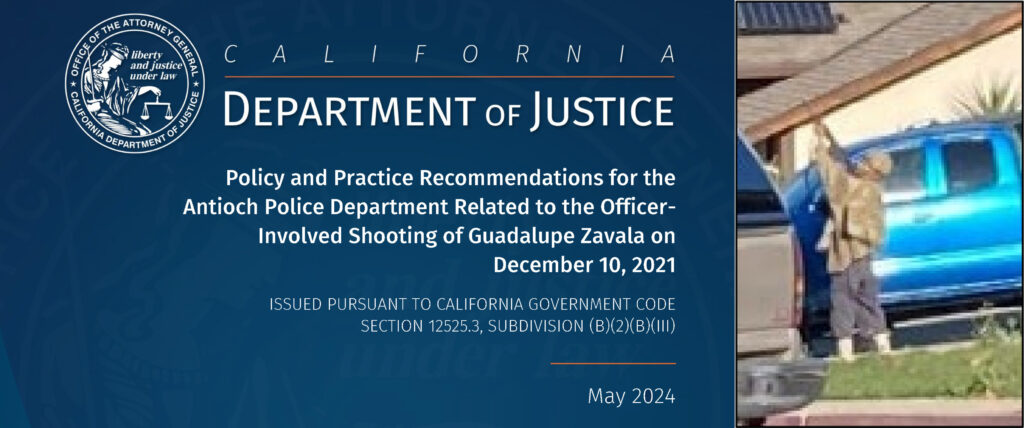
Cover of CA DOJ Policy and Practice Recommendations for APD and Figure 1. photograph from Brentwood Police Department drone footage showing Guadalupe Zavala taking aim and shooting at a police drone. Source: CA DOJ
Guadalupe Zavala caused 6-hour stand-off ending in his death while unarmed; son later sued City of Antioch
CA DOJ “commends APD” for manner in which they handled situation
CA Attorney General issues “policy and practices recommendations”
By California Department of Justice
OAKLAND – California Attorney General Rob Bonta, pursuant to Assembly Bill 1506 (AB 1506), today released a report on Guadalupe Zavala’s death from an officer-involved shooting involving the Antioch Police Department in Antioch, California on December 10, 2021. The report is part of the California Department of Justice’s (DOJ) ongoing efforts to provide transparency and accountability in law enforcement practices. The report provides a detailed analysis of the incident and outlines DOJ’s findings. After a thorough investigation, DOJ concluded that criminal charges were not appropriate in this case. However, DOJ recognizes the important lessons to be learned from this incident. As required by AB 1506, the Attorney General has issued specific policy and practice recommendations related to the incident.

Figure 2: Distance between Mr. Zavala’s house and the location where Officer Duggar and Sergeant Chang were when they fired their shots. Figure 6: This image shows that the distance between Officer Rombough and Detective McDonald (both positioned on the Antioch armored vehicle) and were about 103 feet from Mr. Zavala when they fired. Source: CA DOJ
“Loss of life is always a tragedy,” said Attorney General Bonta. “AB 1506 is a critical transparency and accountability tool, and our hope for this report is to provide some understanding and aid in advancing towards a safer California for all. The California Department of Justice remains steadfast in our commitment to working together with all law enforcement partners to ensure an unbiased, transparent, and accountable legal system for every resident of California.”

Figure 11: Bullet holes photographed in residence neighboring Mr. Zavala’s home where neighbors reported shots fired by Mr. Zavala. Figures 11A&B: Bullets holes in neighbor’s vehicles outside Mr. Zavala’s residence. Source: CA DOJ
On December 10, 2021, Antioch Police Department responded to multiple calls regarding a man who was barricaded in his home with a rifle after shooting at neighboring homes and vehicles. A standoff lasting more than six hours ensued, during which Mr. Zavala fired multiple rounds from various locations towards law enforcement personnel, vehicles, and nearby residences. De-escalation measures, communications from the crisis negotiations team, and attempts to coerce Mr. Zavala from his residence were unsuccessful. At one point, Mr. Zavala exited his front door carrying what appeared to be a “full AR-15 style rifle.” Two snipers with the Antioch Police Department each fired one round hitting Mr. Zavala, causing him to fall back. However, because Mr. Zavala was wearing body armor, he was able to regain his footing and moved back inside the residence. Later, a fire started in Mr. Zavala’s home, and he ran out and took cover in his backyard. When law enforcement knocked down the fence of Mr. Zavala’s yard with an armored vehicle, Mr. Zavala ran towards the armored vehicle and was fatally shot.
Zavala’s son, Diego Zavala, joined in a 2023 federal lawsuit against the City of Antioch and six Antioch Police officers. (See related articles here, here and here)
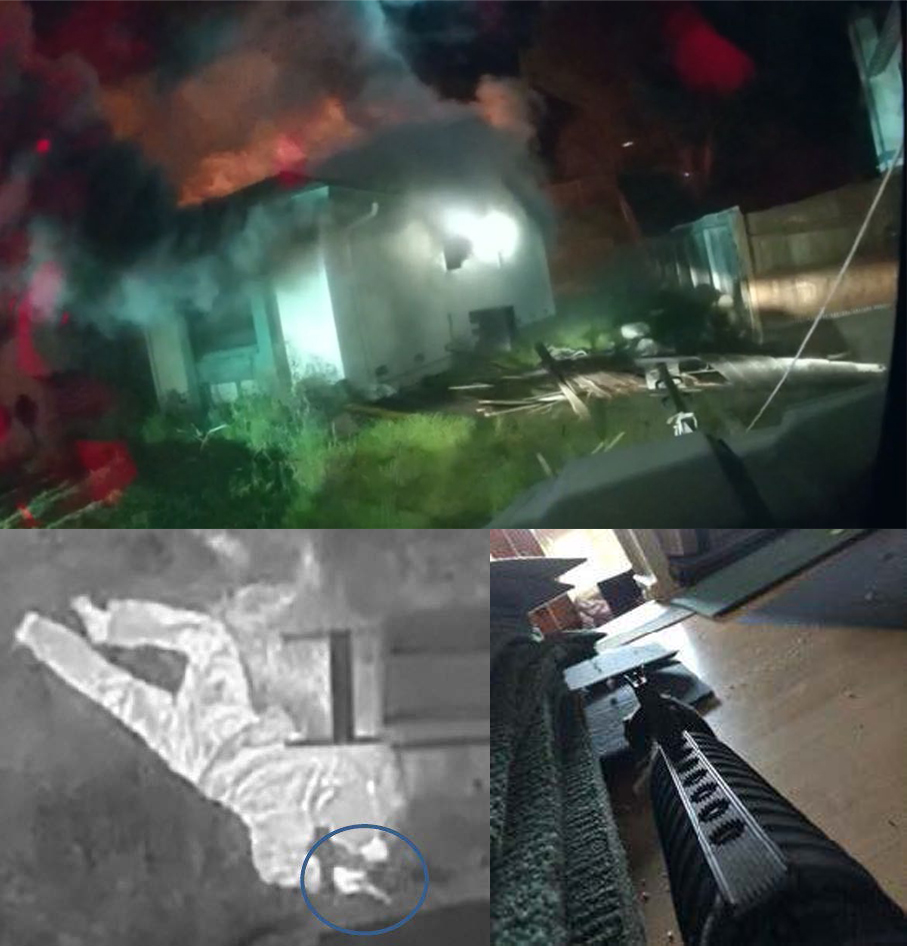
Figure 25: Still frame from armored vehicle video of Mr. Zavala getting up halfway after the first round of shots were fired by officers. Figure 4: Mr. Zavala lying prone outside the North side of his home, under a barbecue, with what the helicopter reported to possibly be a handgun in his hands (circled). Figure 9: Cellphone image from Mr. Zavala’s phone from the day of the incident. Source: CA DOJ
Under AB 1506, which requires DOJ to investigate all incidents of officer-involved shootings resulting in the death of an unarmed civilian in the state. DOJ conducted a thorough investigation into this incident and concluded that the evidence does not show, beyond a reasonable doubt, that the officers involved did not act in lawful self-defense or defense of others. Therefore, there is insufficient evidence to support a criminal prosecution of the officers. As such, no further action will be taken in this case.
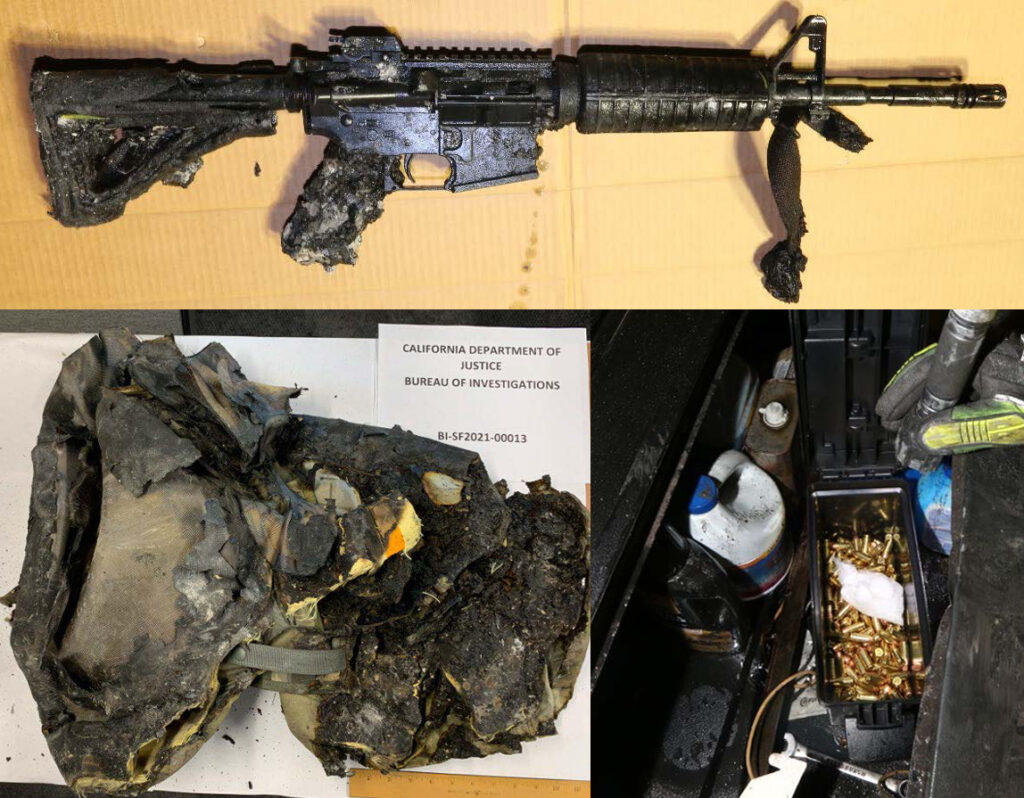
Figure 19. Assault rifle found in the hallway of a bedroom in Mr. Zavala’s residence. Figure 21. Ballistic vest recovered from the backyard. Figure 23: A box of unfired .40 caliber S&W ammunition found in the safe of the master bedroom of Mr. Zavala’s residence. Source: DOJ
CA DOJ “Commends APD” for How They Handled Situation
In addition, the report shows the California DOJ Police Practices Section conducted a supplemental review of the information and “PPS commends APD for the manner in which they handled this volatile, dangerous situation, coordinating with neighboring agencies, exploring less-lethal options, and rapidly deploying the SWAT and CNT teams to the incident to attempt to achieve a peaceful surrender.”
CA DOJ Recommendations
As part of its investigation, DOJ has identified several policy recommendations that it believes will help prevent similar incidents from occurring in the future. These recommendations include:
COMMUNICATION
Antioch Police Department should ensure that officers are equipped with effective communications devices that can operate in the hilly areas covered by their department. Antioch Police Department can seek additional coverage or upgrades through their department-issued cell phone or radio carriers or, if that is impracticable or not feasible, examine whether there are other cell phone carriers or radio channels that would work in all areas they serve.
COMMUNICATION BETWEEN AGENCIES
Antioch Police Department should ensure that their officers can effectively and efficiently communicate with officers from other agencies in future incidents by setting up regional radio channel systems for interagency communication.
See CA DOJ APD Policy Recommendations from Zavala_AB1506 Report
Emails were sent early Friday afternoon to Acting Antioch Police Chief Brian Addington, Antioch Police Officers Association leaders and their attorney, Mike Rains for comment on the report, as well as City Attorney Thomas L. Smith, Addington and Rains with questions regarding the 2023 lawsuit that included Zavala’s son. The efforts were unsuccessful prior to publication time, except for a response by Rains.
Early Friday evening he said, “That was good news from the DOJ. I think the findings were appropriate. The DOJ does a very good job, in my opinion, in these 1506 cases analyzing the facts and clearing the officers of any wrongdoing. I also see the PPS commends the department for de-escalation.”
About the lawsuit Rains said, “I don’t know on the civil side if the lawsuit is settled or not,” as Rains’ firm does not represent former officer Eric Rombough.
“We represented the officers in the 1506 case, including Duggar and Chang, who were the two primary officers who fired their weapons and were part of the DOJ investigation,” he added.
A copy of the complete report can be found here.
Please check back later for any updates to this report.
Allen D. Payton contributed to this report.
Read MoreROAD CLOSURE STARTS TUESDAY for construction of new bike turnouts
By CA State Parks
Starting Tuesday, May 28 South Gate Road will be closed weekdays to all traffic including cars, bicyclists, and pedestrians. Each week for approximately five weeks, the road will be closed from Monday 8 a.m. through Friday 2 p.m. It will be open weekends.
All trails and fire roads will remain open, and visitors who walk or cycle to the park will be able to access Summit Trail at the South Gate Entrance.
During the road closure period, camping at Live Oak Campground, and the Buckeye, Wildcat, and Barbecue Terrace Group Camps will only be available Friday and Saturday nights.
This closure is for the construction of additional bike turnout lanes to enhance road safety. This latest phase of the project was made possible by fundraising coordinated by our partner organization California State Parks Foundation.
There are three other entrances to Mount Diablo State Park: Mitchell Canyon Road, North Gate Road and Green Valley Road (Macedo Ranch). Please check under Brochures/Campground Map for more details. There is no vehicle access to the Summit from Macedo Ranch or Mitchell Canyon.
Thank you for your cooperation during this temporary closure.
For more information about Mt. Diablo click, here.
Allen D. Payton contributed to this report.
Read More

Photos of the 2024 Contra Costa County Fair by Allen D. Payton. See more photos on the @cocoherald Facebook page.
“Not any business, including any business I worked for would take a deposit at night” – Craig Cannon, Contra Costa County Fair Board President
Shares more details, says policies and procedures will be discussed at next Board meeting June 12
Positive Fair news: Mexican rodeo group working to bring Hispanic-themed events to former arena
By Allen D. Payton
Following the armed robbery of proceeds from the Contra Costa County Fair during an attempted bank deposit early Monday morning, May 20, 2024, after the end of this year’s fair Sunday night, on Thursday, Fair Board President Craig Cannon shared additional details about the incident. (See related article)
Asked to confirm the amount of $90,000 that was stolen he said, “I got it as a little under $100,000. I got that from the police. (Fair CEO) Joe Brengle’s not even talking to me.”
However, according to another board member, John Pence, Brengle sent out an email Wednesday night to him and the other board members about the matter. Cannon said he hadn’t seen it.
“Not any business, including any business I worked for would take a deposit at night,” Cannon continued. “It’s unusual. It’s one of the things I want to get the board together to talk about. Why would you make such a poor decision? The only one who has a deposit key is the fair manager.”
“A lot of information is not being shared when it’s supposed to be,” he stated. “It all boils down to the fair manager. He handles the overall money receipts, personnel, hiring and firing. But Joe works for the board. We hire and fire him.”
Asked if insurance will cover any of the loss, Cannon said, “I don’t believe so because it wasn’t during Fair hours or on property and it wasn’t in the bank. There’s a really thin line, there.”
Asked why the people depositing the funds weren’t joined by armed escorts by either the contracted security firm or county sheriff’s deputies, he responded, “That’s the question I’m trying to find out. But he’s (Brengle’s) not being forthright. That’s what we will discuss at the next board meeting. I’ve talked to the State of California, and they said I can’t have an emergency meeting. In my eyes, almost a hundred grand is a major crime against us.”
About the security firm, Praetorian and this year’s Fair, Cannon said, “They were great. This year’s fair was a good one and safe.”
He then reiterated what was shared with other media, that the loss of that amount of money could impact the fair’s music headliners and animal attractions for next year.
“This whole thing stinks,” he stated.
Two Temporary Staffers Handled Deposit
Asked who handled the deposit Cannon said, “Two temporary staffers hired by the Fair, this year in charge of parking and ticket sales. That’s another red flag. Something’s really wrong. Joe seems like a sensible guy. I don’t know why he would make that decision.”
Asked why the money wasn’t left in a safe on the fairgrounds and deposited during daylight, he said, “That’s a decision for the fair manager” and shared that the Fair, technically state’s 23rd District Agricultural Association, currently only has two full-time employees, Brengle and an administrative assistant who works in the office with him.
Since it’s the public’s money Cannon said, “That’s my concern. I also suggested the state bring in the CHP which oversees county fairs in the state. They delegate the authority to the county sheriff’s office.”
“I don’t work for the state,” he explained. “I’m appointed by the governor. Not this governor, the past one. The appointments are renewed. We can barely have a meeting quorum. If someone is sick, we can’t hold a meeting. The governor’s busy with the budget.”
Asked why the funds weren’t taken to the bank by the fair manager and a board member for a check and balance and if there is a procedure in place Cannon stated, “There will be. The Fair Board is all about policies and procedures. The manual is about 50 pages. But we don’t handle the day-to-day. Taking funds to the bank during daylight hours should be the policy.”
“He (Brengle) hasn’t been forthcoming to anyone on the board about this,” the fair board president reiterated. “This is crazy. It makes no sense at all.”
One positive thing Cannon shared is that a Mexican rodeo group is working to bring Hispanic-themed events to the former arena that was used as the paintball park.
The next board meeting, which is open to the public, will be held Wednesday, June 12 at 7:00 p.m. in the Fair Board Directors’ Room at the Contra Costa Event Center (fairgrounds) located at 1201 W. 10th Street in Antioch.
Read More
Briones Regional Park, Alhambra Creek Staging Area 9 AM – 2 PM
By East Bay Regional Park District
 The Briones Trails Pilot Project is a unique opportunity to give back to the parks you love! Help us maintain and enhance Briones Regional Park and create exciting new recreational opportunities on single-track trails and repair impacted natural resources during our Dig Days. The next one will be on Saturday, June 1, 2024. We will make improvements to the P9 Trail (AKA the Desert Hiking Trail) including establishing a more sustainable trail route and restoring a steep and eroding segment.
The Briones Trails Pilot Project is a unique opportunity to give back to the parks you love! Help us maintain and enhance Briones Regional Park and create exciting new recreational opportunities on single-track trails and repair impacted natural resources during our Dig Days. The next one will be on Saturday, June 1, 2024. We will make improvements to the P9 Trail (AKA the Desert Hiking Trail) including establishing a more sustainable trail route and restoring a steep and eroding segment.
The two-yearpilot project is intended to test a variety of trail management strategies. The pilot project is limited to a portion of Briones Regional Park in the northeast corner of the park. See Project Map (or below). The pilot project was launched on Friday April 21, 2023.
The Briones Pilot Project establishes specific rules limiting trail use within the Pilot Project Zone and for two trail segments adjacent to the Pilot Project Zone, such as hiking only, biking only, or biking/hiking only and direction of travel. On weekends, trail use within the Pilot Project Zone will alternate days between bicycle and equestrian use based on even and odd calendar dates (see table). A key component of the Project is the restoration of illegally built “bootleg” trails to protect natural habitat for wildlife.
Please make sure to bring a water bottle and be prepared to work! There is poison oak in the area, so please wear work pants, long sleeves and good close-toed work shoes.
You are welcome to ride in, but you will need to provide your own bike and helmet.
June 1st Dig Day – 9:00 AM meet-up and post-dig lunch at Alhambra Creek Staging Area, 273-181 Brookwood Drive in Martinez.
Registration and Info: ebrpd.samaritan.com/custom/501/opp_details/6729
- Age Restrictions: Youth under the age of 18 must have a signed permission by parent or legal guardian. Youth under the age of 13 must be accompanied by an adult.
- Description: Join us to maintain and improve select trails and restore habitat! Learn the basics of restoration and trail work during our dig-days lead by Regional Parks staff.
- What to Bring: water bottle, helmet, mountain bike, gloves, and PPE.
- What is Provided: Necessary tools. We will have work gloves and protective eye wear for participants.
- Weather: Heavy rain or unsafe wildfire smoke conditions cancel the program. Please wear layers as Bay Area weather can be unpredictable.
The Briones Pilot Project reached its one-year mark on April 21, 2024. The two-year pilot project was planned and created to test new ways to safely share trails and improve the trail experience for all users while protecting habitat, wildlife, and watersheds. The pilot project is limited to a portion of Briones Regional Park in the northeast corner of the park. Share your thoughts and feedback on the past year of progress at the next in-person check-in meeting on June 15. Members of the community are invited to Briones to discuss the pilot project’s progress and share ideas with District staff and other trail users.
Why a Pilot Project?
Over the last decade, the number of visitors to District parks has increased significantly. The rise in numbers of visitors getting out onto trails has increased the potential for conflict between different types of trail users. Although the Park District is seeking to open new parks and provide more trails to reduce crowding on trails, the trail development process takes time. The pilot project will test some new ways to safely share trails and improve the trail experience for all users while protecting habitat, wildlife, and watersheds.
Project Objectives:
- Protect Resources, Habitat, Wildlife, and Watersheds: The expansion of illegal bootleg trails is a significant issue for Briones and other East Bay regional parks. These user-built trails are often not built to sustainable trail standards with appropriate drainage and avoidance of sensitive natural habitats. Illegal trails can have negative impacts on wildlife and watersheds. The project will include a robust monitoring and patrol program to document and prevent the expansion of bootleg trails in the pilot project zone.
- Restore Natural Habitat by Closing Illegal Bootleg Trails in the Pilot Project Zone: A primary objective of the project is to engage with the trail user community to join park staff in restoring natural habitats already impacted by illegal bootleg trails.
- Enhance the Trail User Experience: The trail management strategies being tested during the two-year pilot project are intended to allow users to safely enjoy trails by providing specific days when certain user types are limited to create more space on trails.
- Increase Volunteer Engagement in Trail Maintenance and Habitat Restoration: Community volunteers play an important role in helping park staff monitor and maintain park trails. The pilot project provides volunteer opportunities for trail users to join in trail maintenance and habitat restoration activities.
For more information visit Briones Trails Pilot Program or call Volunteer Services at (510) 544-2229.
Read MorePossibly $90,000, police seek public’s help
By Antioch Police Department
On Monday, May 20, 2024, at approximately 2:18 AM, Antioch police officers responded to the 2500 block of Somersville Road for the report of an armed robbery.
When officers arrived, they contacted two victims. Officers learned the victims were employees of the Contra Costa County Event Park (Fairgrounds). The Contra Costa County Fair had ended, and two employees were tasked with conducting the night deposit. While conducting the night deposit at the BMO Bank they were approached by an unknown suspect. The suspect robbed the victims of the money and personal belongings at gunpoint.
Other news reports have pegged the amount stolen at $90,000. When asked, a county fair representative offered no comment but didn’t know how that amount was known by other media. Questions were emailed late Wednesday night to Fair CEO Joe Brengle asking if that’s correct, why the deposit was made at that time instead of leaving it in a safe on the fairgrounds and waiting until Monday morning to make the deposit, what is the usual procedure and for any additional information he could share.
We are asking for anyone with information regarding the incident to contact the Antioch Police Department Investigations Bureau. Additional inquiries or information can be directed to Antioch Police Detective Sgt. Palma at (925) 779-6876 or by emailing kpalma@antiochca.gov.
Please check back later for any updates to this report.
Allen D. Payton contributed to this report.
Read More











